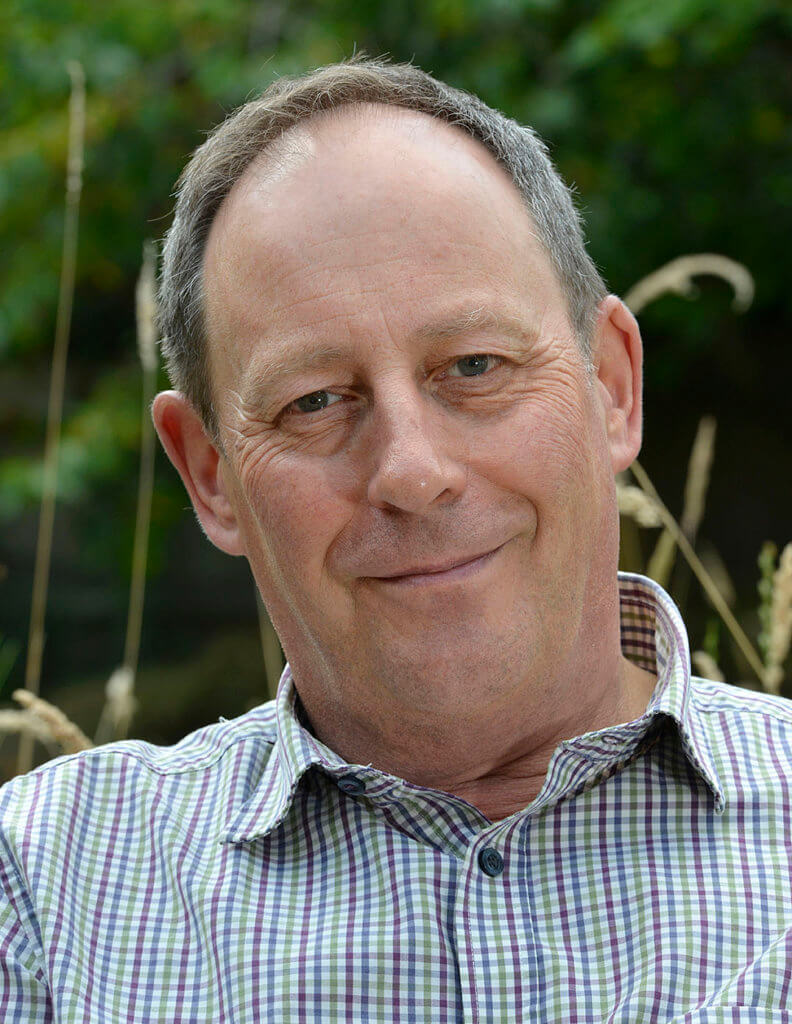
Paul Sterry has an academic background in freshwater biology and is a passionate conservationist. He has been writing about natural history and photographing wildlife for the last 40 years, with an emphasis on the British scene.
Rewilding – a personal perspective
There was a time in my life when the worst question you could ask me was ‘Where were you born?’ I would squirm and try to change the subject but if pressed I had to answer ‘Basingstoke’. In my formative years this was a source of deep embarrassment. Jane Austen may have lived nearby, naturalist Gilbert White and legendary conservationist Mark Carwardine may have gone to school in the town, two centuries apart obviously. But mention of its name in the big, wide world invariably produced eyebrow-raising reactions ranging from sneering pity to outright derision. Less-than-flattering references to the town date back to Gilbert and Sullivan’s Ruddigore, and at one time Country Life readers apparently voted the town centre the sixth ‘most hated eyesore’ in the country; it couldn’t even get that right and be the ‘most hated’. No, as a town Basingstoke had nothing to commend it as far as I was concerned when I was growing up.
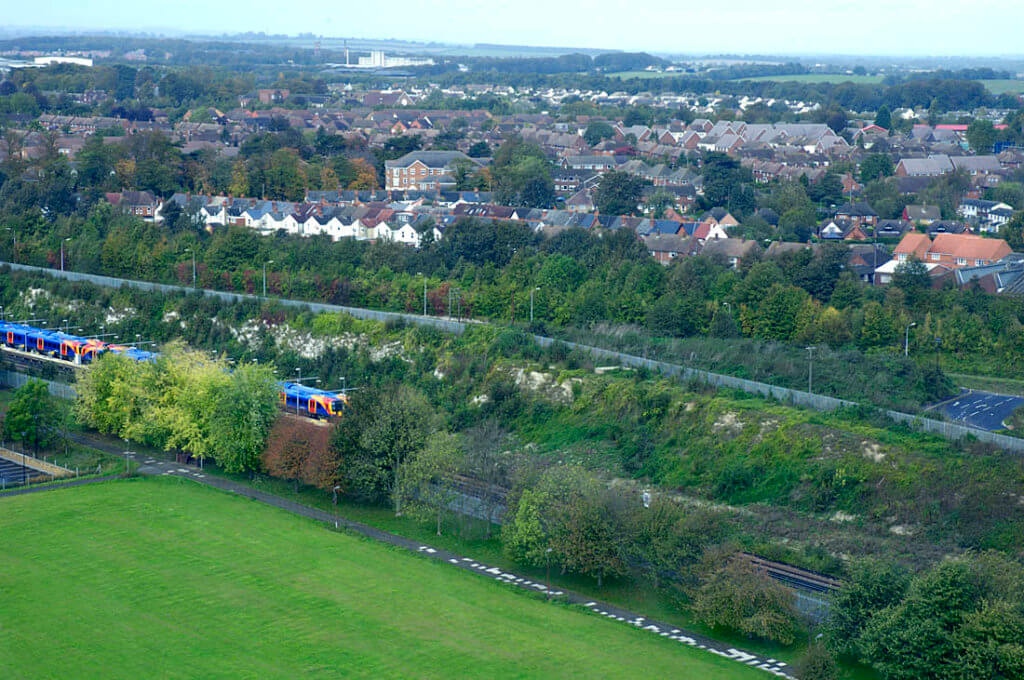
An aerial view of Basingstoke taken a few years ago. Some of the green fields in the distance are now ‘infilled’ of course as the march of progress continues. Photo: Paul Sterry – Nature Photographers Ltd
But Basingstoke’s wildlife was a different matter and the countryside that embraced it in my youth was where I cut my natural history teeth. So perhaps it was not so surprising that after an absence of a decade or more I found myself drawn back to the area, lured not by the cultural appeal of the town but by the biodiversity of the surrounding area. With a hint of Proustian nostalgia, as I drive Basingstoke’s dual carriageways today I am still reminded of distant childhood memories of Small Blue colonies, fields harbouring what I now know to be Pheasant’s-eye, and ponds seething with Great Crested Newts. Mostly gone of course, buried under tarmac, concrete and bricks. But vestiges of Basingstoke’s past wildlife glory persist, for now, in what passes for countryside in this part of north Hampshire.
Today I live in the Parish of Pamber to the north of the brave new world that is modern Basingstoke. It’s an area extraordinarily rich in biodiversity. Nearly 25% of the land in the Parish has SSSI status (mainly Pamber Forest nature reserve). And it contains roughly 37% of SSSI land for which Basingstoke and Deane Borough Council is the Local Planning Authority, although you could perhaps interpret this as a reflection on the rest of the Borough.
Not to belittle it, but Pamber Parish’s good fortunes in the biodiversity department are down to luck. Underlying clay and gravel mean the land is agriculturally poor and for centuries it was fit for little more than growing trees, cutting hay and grazing a few animals. Land ownership and tenancy regimes meant much of the population scratched a living from relatively small plots: one man with an axe and a scythe, and not much more. This historically small-scale, English-style subsistence farming resulted in a mosaic of land use and habitats that persists in Pamber today, in places. And looking at old maps and reading the landscape’s archaeology and ancient hedgerows means you can trace the history of land use back to the days of Roman occupation.
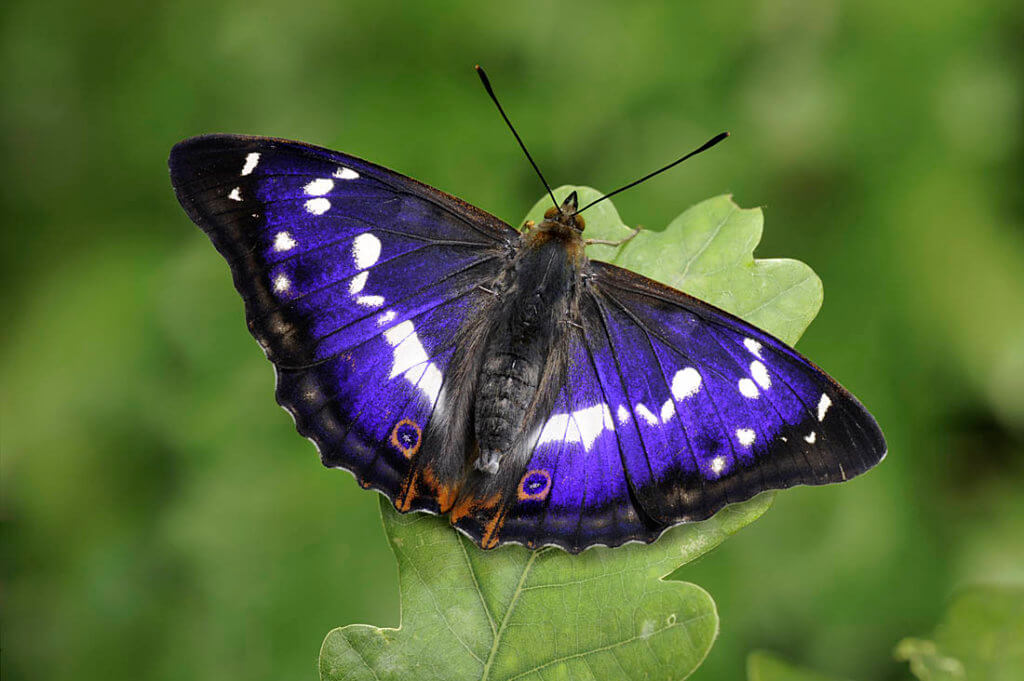
For previous generations of entomologists Pamber Forest was the ‘go-to’ place to see (and in those days collect) Purple Emperors. This magnificent butterfly is still present in good numbers, thanks in part to the nature reserve’s warden looking after its larval foodplant, Goat Willo Photo: Paul Sterry – Nature Photographers Ltd.
The landscape of Pamber Parish is a palimpsest. What a lovely word. Think of it as an ancient parchment manuscript, used and reused over time with previous text and boundaries scraped away and overwritten but not entirely obscured. Hints of the past can be discerned by those with a keen and informed eye. For anyone curious about the subject, the following scholarly article makes interesting reading: Rural History (2011) 22, 2, 159-181. Cambridge University Press. Woodland Management in Hampshire 900 to 1815. Alan Albery.
Within walking distance of my house I can find every widespread British reptile and amphibian species and almost all the butterfly species you could reasonably expect in lowland England, not to mention birdlife ranging from Dartford Warbler to Woodcock. A Wild Service-tree grows in the hedge bordering my garden, in spring I hear Skylarks singing overhead and each year I receive visits from wandering Purple Emperors and the occasional Kingfisher patrolling my stream.
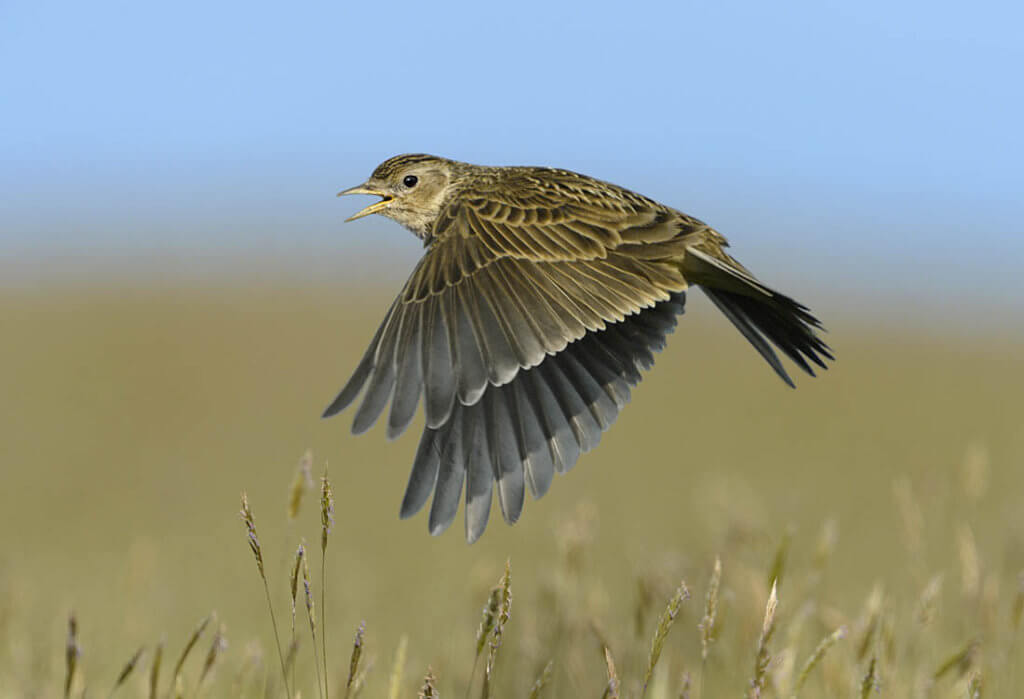
Skylarks still sing in the parish of Pamber, nesting in meadows cut for hay rather than arable farmland. Photo: Paul Sterry – Nature Photographers Ltd
Sounds idyllic doesn’t it? But the reality of living in this part of north Hampshire is slightly different. It is subject to the same sort of pressures as anywhere else in southern England with the countryside being eroded and degraded by the blight of progress. Surrounding me are landowners who either want to squeeze every penny from their land or view it as a playground and theirs to wreck. All perfectly legal of course. Well, not all their activities actually but that’s another story. Anyway, rural industrialisation, house building and agricultural intensification: you name it and Pamber’s countryside experiences it all.
One of the most insidious marks of progress has been the entirely legal agricultural destruction of ‘unimproved’ hay meadows, ruined by being ploughed and turned into more profitable arable land; despite the underlying poor soil, that’s a viable financial proposition these days what with drainage, fertilisers and subsidies. Nothing special about meadows you might say, grass is grass. But open your eyes and you’ll see that unspoilt species-rich grassland is a rare commodity in this part of southern England. Loss of good quality meadow saddens me just as much as industrialisation.

As a sign of a healthy natural balance, a fair number of my garden butterflies fall prey to well-camouflaged crab spiders, lurking on flower heads. Photo: Paul Sterry – Nature Photographers Ltd
Meadow-loss a decade or so ago right on my doorstep was a shock. I found I missed the clouds of Meadow Browns and Ringlets that used to drift into my garden in the summer months. But mourning aside, it became a bit of an inspiration and caused me to re-think my approach to gardening. Isolationist and delusional I might be, but I decided to garden for biodiversity, and since then have created my own, albeit modest, nature reserve.
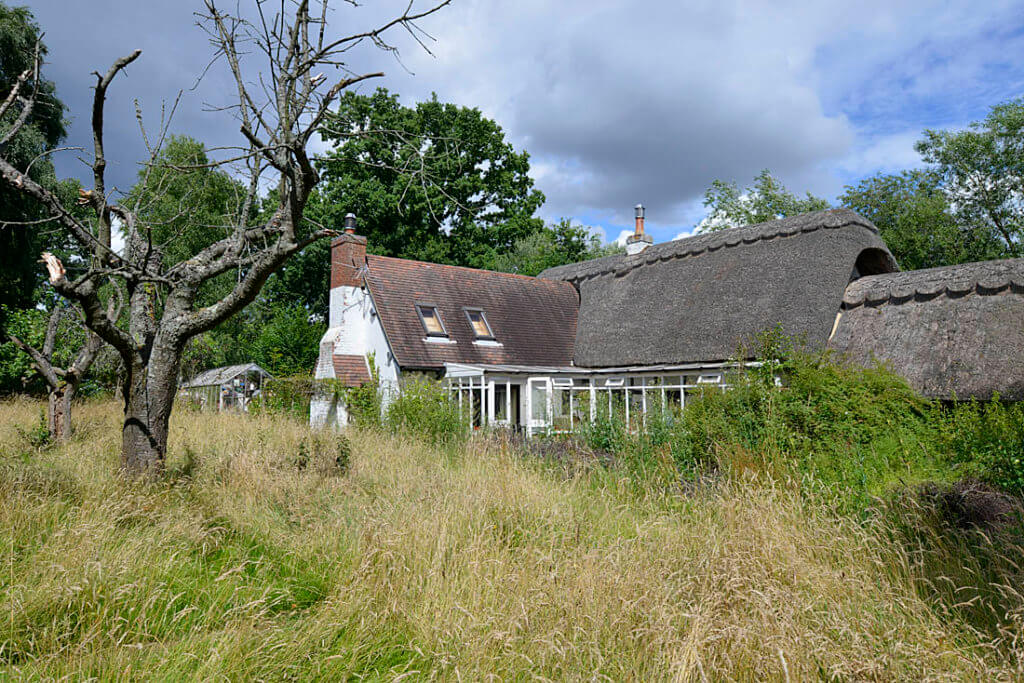
Three years into the ‘re-meadowing’ experiment and seven grassland butterfly species were breeding, including Common Blue and Marbled White. The standing dead trees in the picture are riddled with Sinodendron cylindricum (the miniature rhinoceros beetle) and Lesser Stag Beetle Dorcus parallelipipedus. Photo: Rob Read – Nature Photographers Ltd
I now cut what was previously lawn once a year and have a wonderful grassy meadow in miniature as my view in the summer months. By nurturing larval foodplants, seven species of grassland butterfly breed in my garden and they contribute to the more than 400 lepidoptera species that have been recorded here over the last two decades. Four species of orchid have appeared out of nowhere and every year a new native wildflower species makes its welcome but uninvited appearance; last year it was Grass Vetchling.
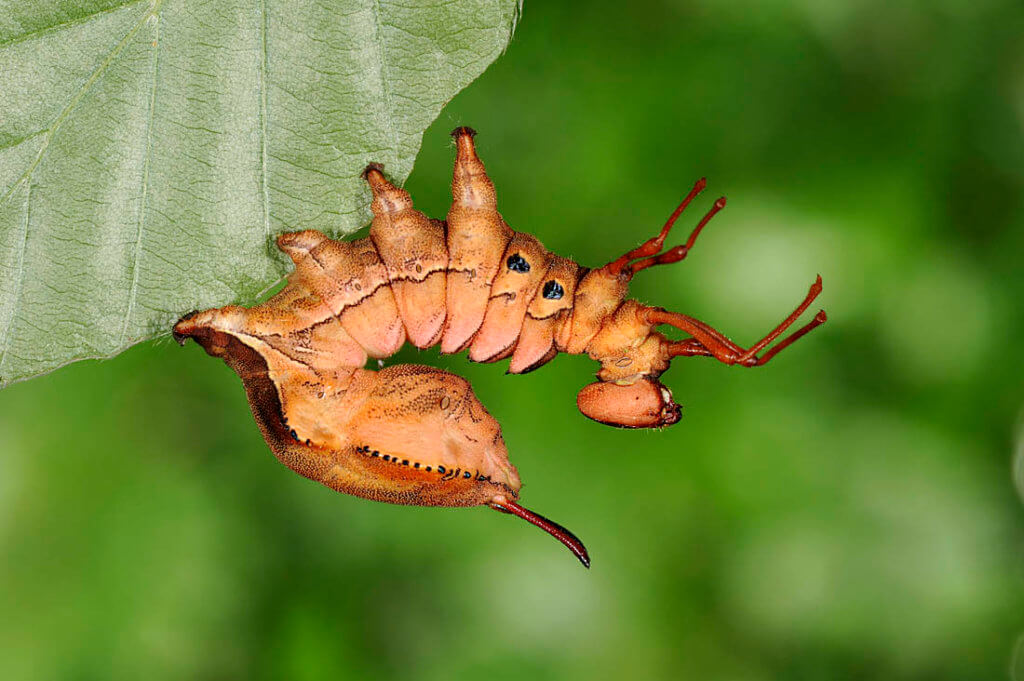
Adult Lobster Moths are regulars in my moth trap but only rarely do I come across their extraordinary larvae. Photo: Paul Sterry – Nature Photographers Ltd
Inspiration for meadow creation came in part from talking to a fellow Pamber-resident who owns SSSI-designated meadows in the parish. It turns out that as recently as the 1950s these were agricultural fields, serving a variety of non-intensive purposes. Their ‘restoration’ occurred naturally without any intervention other than a sympathetic cutting regime. The most significant factors aiding meadow recovery at this site were that agricultural sprays and fertiliser had never been used (hence the soil seedbank remained intact), and a rotation of land-use meant there had always fallow pockets of land to act as reservoirs of biodiversity, allowing recolonisation to occur elsewhere subsequently. If you are interested, take a look at British Wildlife Magazine, volume 11, no.1, 1999. Agriculture and wildlife conservation: accident or design? Alan Albery. So doing nothing, or very little, really can create a positive outcome for biodiversity.
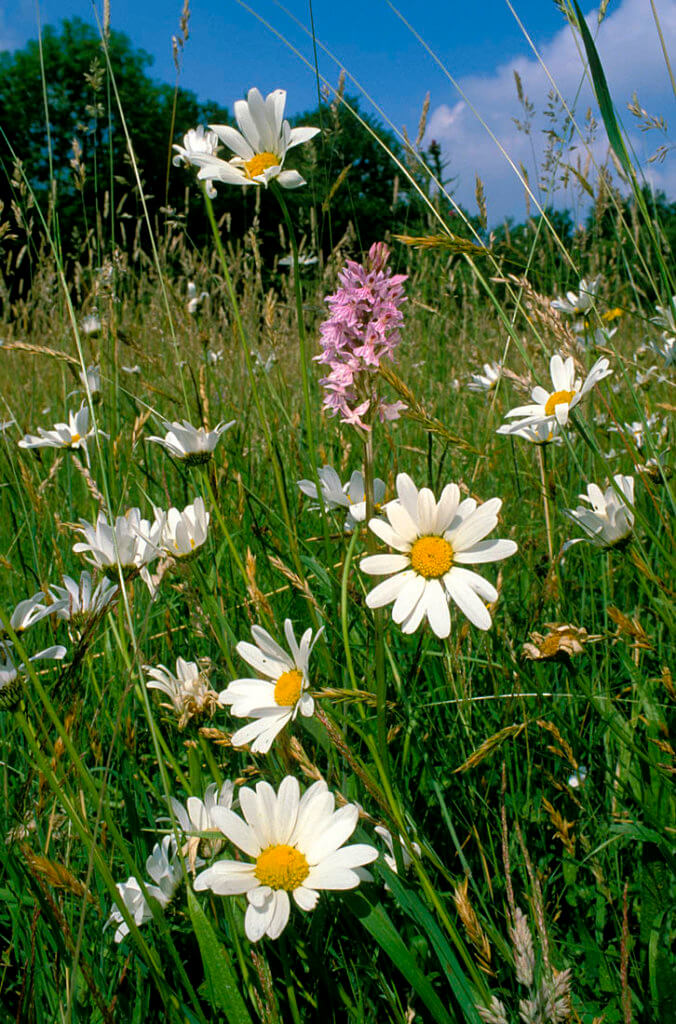
A flower-rich ‘unimproved’ meadow in Pamber, restored to its former glory by 40 years of sympathetic management. Photo: Paul Sterry – Nature Photographers Ltd
And then there’s my pond. In an effort to benefit aquatic life and increase diversity, three years ago I created one. It has been a source of endless pleasure and a practical example of ‘build it and they will come’. But unlike their Biblical forebears the amphibians came, not two-by-two, but in their dozens. Before long it was heaving with Common Frogs, Common Toads, Smooth Newts and Palmate Newts in spring, a mix that is not destined to last with winner and loser species to be determined over time. And this year, out of the blue, Great Crested Newts made a surprise appearance. Then there are the dragonflies and damselflies that are a delight to watch as they patrol the pond margins during the summer months.
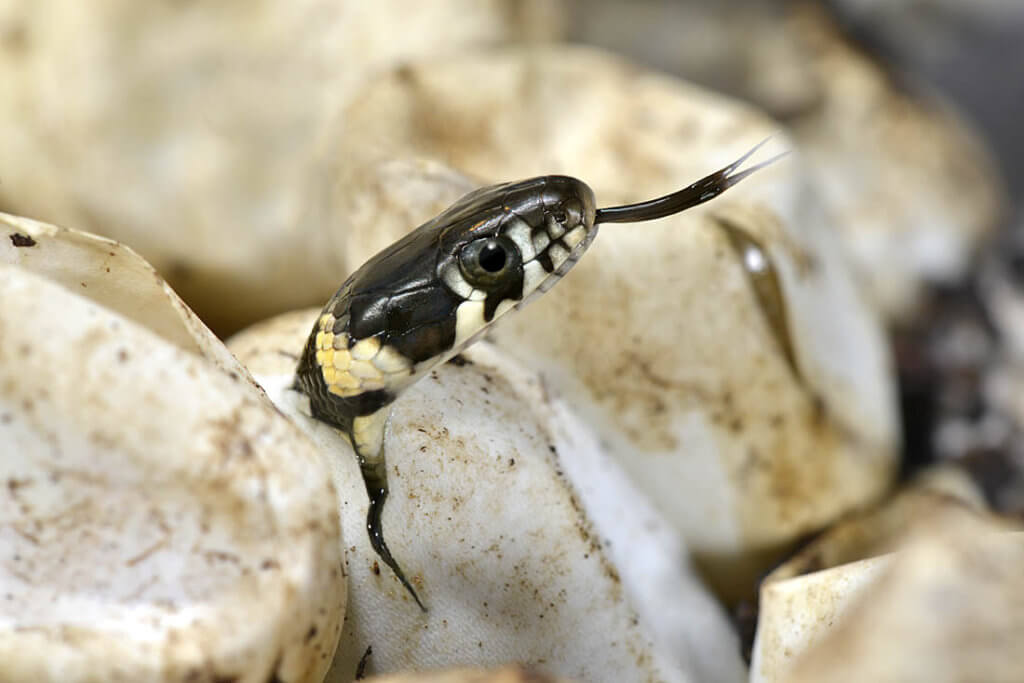
Grass Snakes are present year-round in the garden and occasionally lay their eggs in strategically-placed compost heaps and grass piles. Photo: Paul Sterry – Nature Photographers Ltd
When I made the switch to gardening for biodiversity ten years ago it felt like the most practical way I could help wildlife and redress some of the harm done by my neighbours. Nowadays it would probably be called rewilding. Whatever name you give it, gardening for wildlife and creating pockets of biodiversity from which recolonisation can occur elsewhere can only be a good thing for conservation. Combine that with the concept of continuity and connectivity if neighbours share your approach and join in, and you have a potentially powerful tool.
But something about spending the best part of five decades in this part of north Hampshire brings out the sceptic in me. The only local landowners I have come across who are actively rewilding are ones who can afford to or who don’t make a living from the land. All praise to them of course. But I struggle to imagine my ‘farming’ neighbours embracing the concept. Especially since, in a neighbouring parish (and just into Berkshire) what might be called reverse-rewilding is standard practice. From Silchester to Padworth and beyond lie vast tracts of land planted with trees a century or so ago. Today, immense pines and scattered oaks cover the landscape; carpets of Bilberry and heathland flowers cloak the woodland floor; Nightjars and Woodcock nest in secluded spots; some of the largest Adders I have ever seen bask in the clearings and rides; and the summer air is filled with the sound of buzzing insects.
What’s the strategy with this prewilded landscape? Clear-fell the trees on an industrial scale, remove the topsoil, extract the gravel and allow water to collect in the craters (sorry, create new wetland habitats). Apparently that’s a positive outcome for wildlife. For water-loving newcomers that might be true but not so much for the land’s former inhabitants. A more honest description of the activity might be straightforward commercial exploitation of the land. Perhaps the notion that ‘nothing lasts forever’ is something to bear in mind when we consider the long term prospects for rewilding: economics will always be a factor and land-ownership is a vital element.
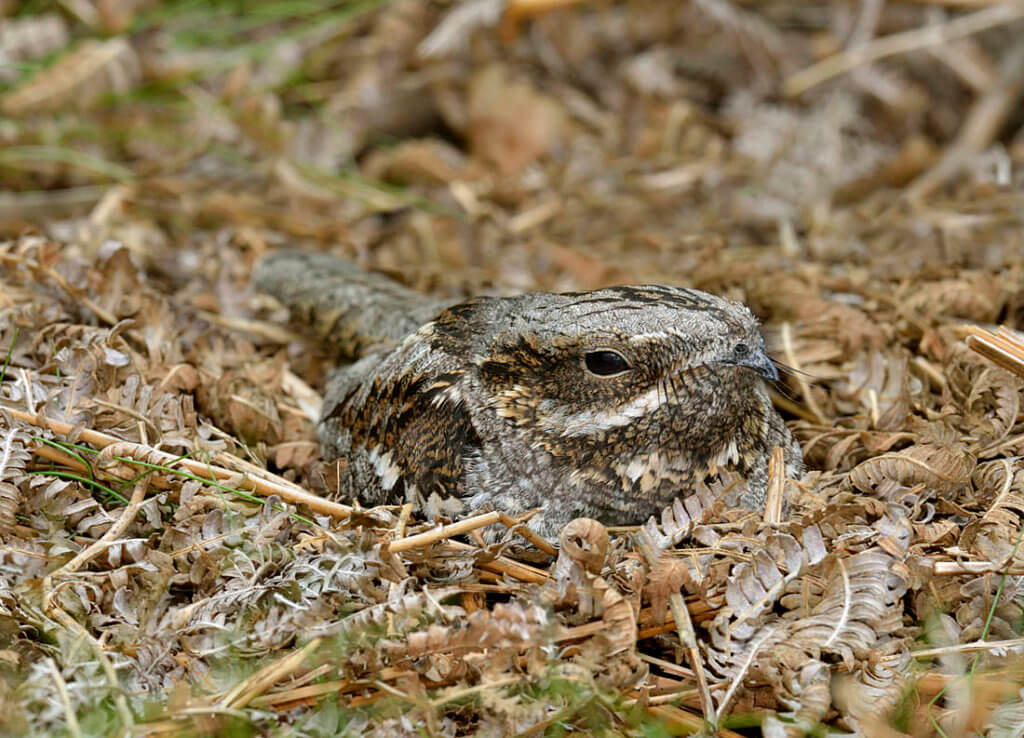
Among the losers of reverse-rewildling (at least in the short-term) are ground-nesting and roosting birds such as this Nightjar. Photo: Paul Sterry and Rob Read – Nature Photographers Ltd
Given my personal experiences you can perhaps understand why I have a few reservations about rewilding – not the intent obviously, but the long term outcome. I sincerely hope that more than well-intentioned and well-heeled landowners embrace the concept in the countryside at large. But where I live I fear money will always be the deciding factor when it comes to what happens to the land. And looking to the future I can imagine changing fortunes might alter attitudes among future-generation owners of previously rewilded land.
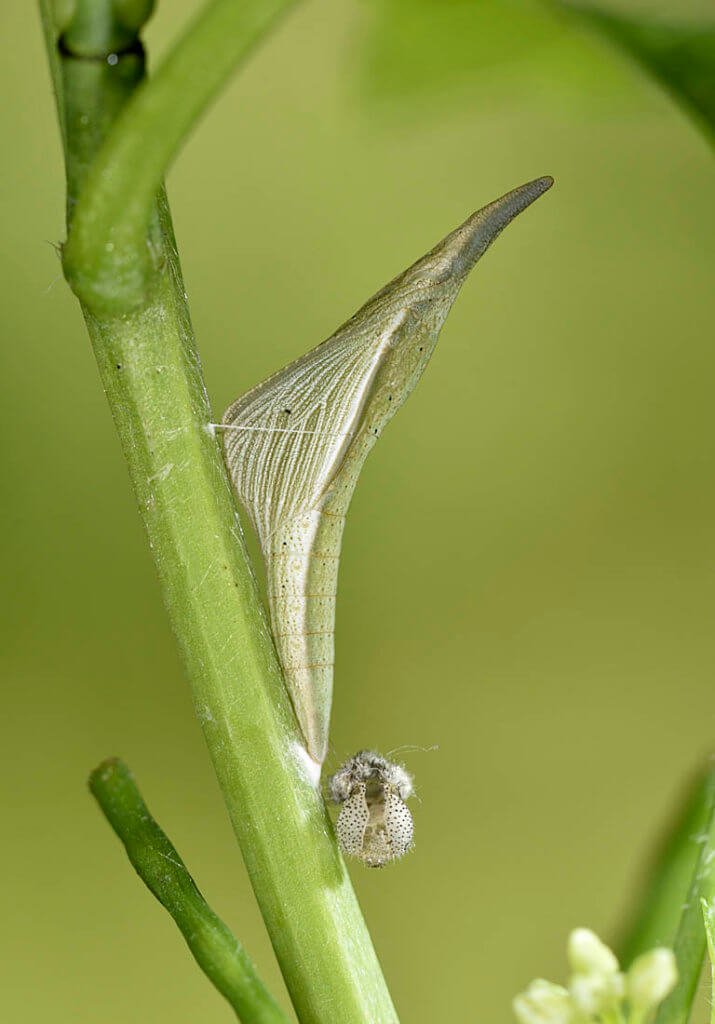
Nurturing patches of Garlic Mustard, and safeguarding their withered stems throughout winter ensures that the life-cycle of the Orange-tip is completed in my garden. Here we see a well-camouflaged pupa attached to the stem of the larval foodplant. Photo: Paul Sterry – Nature Photographers Ltd
Perhaps it is the small-scale end of the spectrum where the approach will gain more traction – in urban and suburban settings where there’s more chance of neighbours having shared interests, and fewer vested interests. But wherever you live and no matter how much land you own, please do something. You can hardly complain about the ineffectual nature of statutory conservation in Britain and the shortcomings of wildlife charities unless you are doing everything you possibly can yourself.
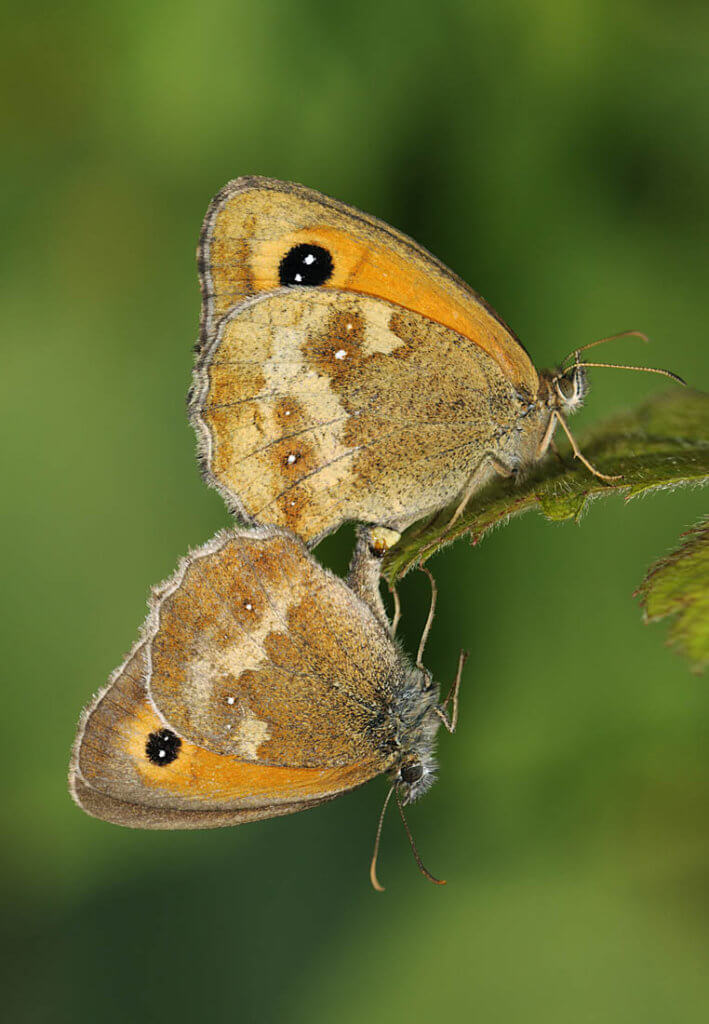
For any budding ‘rewilder’ there are few more encouraging signs than the sight of breeding butterflies. When I see Gatekeepers in relative abundance, I think ‘surely I must be doing something right?’. Photo: Paul Sterry – Nature Photographers Ltd
I hear whispers on the grapevine that my local and county councils are making noises on the conservation front: apparently rewilding Basingstoke is the next big thing. The scope to do that is limited of course, short of tearing down the town centre and planting trees. I would like to take them seriously of course but would be more inclined to do so if they showed signs of wanting to protect the wildlife that remains. Installing toad tunnels on Cufaude Lane would be a step in the right direction; and they could time the cutting of roadside verges to benefit wildflowers rather than to slot in with idle periods in the cutters’ calendar. I realise I will never see the pre-urbanized Basingstoke of my youth but a few more orchids – blooming rather than cut-off in their prime – wouldn’t be a bad thing. An even bolder step would be to set-aside council-owned land in perpetuity for wildlife, rather than for housing.
[registration_form]
Thank you – inspiring read, albeit with moments of reality/dismay about the march of ‘progress’ . Our lawn, for three years, has been longer grass with a couple of mown paths. We have lots of plants for pollinators. We’re in a town yet the insect life is already teeming in our little patch. I helped co-found Wild Maidenhead in 2016; we already have nearly a thousand supporters. It’s a start. We piloted a Wild About Gardens Awards scheme last year in one village (Cookham) and 49 gardens entered, of which 27 achieved ‘Gold’. These awards have now been rolled out across the ten wards of western side of our borough. If every garden went 10% wild, that would be a 300 acres for wildlife. Not there yet. Small steps, every single garden vital. http://www.wildmaidenhead.co.uk/waga if anyone is interested
Bloody hell that’s impressive!
Agree Les. Jan’s scheme is brilliant conservation education and action.
Yes to more Jan-type initiatives; yes to more backdoor-people naturalists; yes to more 10% rewildings. But yes also, to lots of eco-friendly new houses and flats in order to overcome the chronic lack of affordable and pleasant accommodation across the UK.
Rehouse and rewild – you can easily have both in a country with loads of dosh and yes, despite all that urban sprawl, masses of space everywhere.
And Paul thanks for this essay. Agree – palimpsest – a fabulous word for describing the historic landscape. Thanks for making me look it up.
That’s one hell of a pad you live in.
Marvellous to read about your wildlife oasis, and something to feel cheerful about. Many thanks! I too am letting the grass grow long on a former large & useless lawn and like you am finding different flowers appearing. I look forward to my first orchid! I still have some conventional garden areas and I now feel guilty about clearing garlic mustard. I will look on it more favourably in future.
A lovely post Paul.
Great post, where I grew up in North Yorkshire all the local ” wild flower meadows” went in the early seventies, along with most of the insect fauna. the birdlife is much the poorer for both that and the demise of the few arable fields of that old fashioned ,” mixed farming economy” The ponds are still there along with their inhabitants but in a green desert of rye grass fields. What you have Paul may not be a patch on what has been lost and even though I have moved to rural mid Wales many of us envy your biodiversity as well as photographic skill.
Inspirational
What a positive account!
Old-fashioned Natural History promotion on your doorstep.
And all power to Jan Stannard’s elbow too, setting such an encouraging example.
I love this Paul, and would like advice from you. Roger is always talking about your wonderful wildlife pond.
Your article is inspirational.